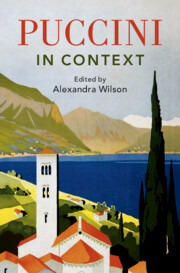Book contents
- Puccini in Context
- Composers in Context
- Puccini in Context
- Copyright page
- Contents
- Figures
- Table
- Notes on Contributors
- Preface
- Part I Formative Influences
- Part II Puccini’s Places
- Part III Influences and Interests
- Part IV Bringing Puccini to the Stage
- Part V Image and Reputation
- Part VI Puccini through a Political Lens
- Part VII Interpreting Puccini
- Chapter 26 Editing Puccini
- Chapter 27 Puccini on Video
- Chapter 28 Interpreting Puccini on Stage and on Disc
- Chapter 29 Producing Puccini Today
- Part VIII Legacy
- Bibliography
- Index
Chapter 29 - Producing Puccini Today
from Part VII - Interpreting Puccini
Published online by Cambridge University Press: 31 August 2023
- Puccini in Context
- Composers in Context
- Puccini in Context
- Copyright page
- Contents
- Figures
- Table
- Notes on Contributors
- Preface
- Part I Formative Influences
- Part II Puccini’s Places
- Part III Influences and Interests
- Part IV Bringing Puccini to the Stage
- Part V Image and Reputation
- Part VI Puccini through a Political Lens
- Part VII Interpreting Puccini
- Chapter 26 Editing Puccini
- Chapter 27 Puccini on Video
- Chapter 28 Interpreting Puccini on Stage and on Disc
- Chapter 29 Producing Puccini Today
- Part VIII Legacy
- Bibliography
- Index
Summary
This chapter considers recent trends in Puccini staging and direction. It notes that Puccini productions have tended to be ‘safe’ compared with the works of composers such as Wagner, inviting audiences to sit back and enjoy rather than sit back and pay attention: Regieoper has tended to avoid Puccini. Recently, however, Puccini’s operas have been subjected to some more unusual and innovative directorial treatment, in productions that are designed to speak to an audience viewing in cinemas and at home as much as in the theatre. Three productions are discussed as case studies. The first is Richard Jones’s 2007 Covent Garden production of Gianni Schicchi, situated in a kitschily decorated mid-twentieth-century British working-class home. The second is Stefan Herheim’s bleak, resolutely unsentimental 2012 La bohème for the Norwegian National Opera, which flips between a contemporary cancer ward and flashbacks using nineteenth-century-style sets long used at the same theatre. The third is Christophe Honoré’s 2019 production of Tosca for Aix-en-Provence, which also intermingles past and present productions, making intertextual reference to the opera’s earlier performance history.
- Type
- Chapter
- Information
- Puccini in Context , pp. 238 - 244Publisher: Cambridge University PressPrint publication year: 2023

